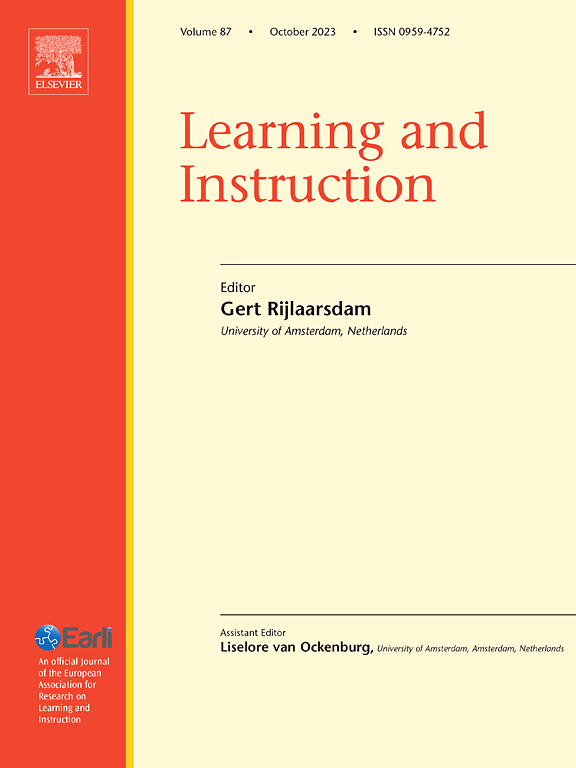Tracing students’ practice behavior in an adaptive math learning program: Does it mediate the math anxiety–performance link?
IF 4.9
1区 教育学
Q1 EDUCATION & EDUCATIONAL RESEARCH
引用次数: 0
Abstract
Background
It has been suggested that math anxiety negatively affects students’ performance because math anxious students avoid math-related tasks. As most studies that investigated this assumed relationship focused on self-report measures to assess avoidance behavior, approaches that use objective process measures, which are less likely to be affected by biases, are needed.
Aims
We conceptualized avoidance behavior in terms of trace data within an adaptive arithmetic learning program. We used a three-wave longitudinal study design to approach the question of how math anxiety is associated with learning behavior that contributes to math performance improvement in school.
Sample
The study comprised 890 fifth-grade students.
Methods
We traced students’ practice (i.e., total number of tasks completed and average number of tasks completed before quitting a session within the learning program) over 45 weeks. Math anxiety was conceptualized multidimensionally.
Results
The mediation analyses showed that math anxious students did not complete fewer tasks overall, but completing more tasks was linked to performance improvement. However, math test anxious students, on average, completed fewer tasks before quitting a session, which explained their weaker performance.
Conclusions
As only math test anxious students displayed higher levels of quitting, we conclude that the perceived context of the program (i.e., as a test) might play a role and that granularity seems to matter regarding the operationalization of process-measured avoidance behavior. Additionally, practitioners need to encourage students to practice persistently with adaptive math learning programs, as this contributes to students’ performance improvement.
跟踪学生在适应性数学学习计划中的实践行为:它是否介导数学焦虑与成绩的联系?
研究表明,数学焦虑会对学生的表现产生负面影响,因为数学焦虑的学生会回避与数学相关的任务。由于大多数调查这种假设关系的研究都集中在评估回避行为的自我报告措施上,因此需要使用不太可能受偏见影响的客观过程措施的方法。目的根据自适应算法学习程序中的跟踪数据对回避行为进行了概念化。我们采用三波纵向研究设计来探讨数学焦虑如何与有助于提高学校数学成绩的学习行为相关联。这项研究包括890名五年级学生。方法:我们跟踪了学生在45周内的练习情况(即,在退出学习计划的一个阶段之前完成的任务总数和平均完成的任务数量)。数学焦虑的概念是多维的。结果中介分析表明,数学焦虑的学生总体上并没有完成更少的任务,但完成更多的任务与成绩提高有关。然而,数学考试焦虑的学生在退出考试前平均完成的任务更少,这解释了他们表现较差的原因。结论:只有数学考试焦虑的学生表现出更高的放弃水平,我们得出结论,程序的感知上下文(即,作为一个测试)可能起作用,粒度似乎对过程测量回避行为的操作化很重要。此外,实践者需要鼓励学生坚持练习适应性数学学习计划,因为这有助于学生的表现提高。
本文章由计算机程序翻译,如有差异,请以英文原文为准。
求助全文
约1分钟内获得全文
求助全文
来源期刊

Learning and Instruction
Multiple-
CiteScore
11.30
自引率
4.80%
发文量
109
期刊介绍:
As an international, multi-disciplinary, peer-refereed journal, Learning and Instruction provides a platform for the publication of the most advanced scientific research in the areas of learning, development, instruction and teaching. The journal welcomes original empirical investigations. The papers may represent a variety of theoretical perspectives and different methodological approaches. They may refer to any age level, from infants to adults and to a diversity of learning and instructional settings, from laboratory experiments to field studies. The major criteria in the review and the selection process concern the significance of the contribution to the area of learning and instruction, and the rigor of the study.
 求助内容:
求助内容: 应助结果提醒方式:
应助结果提醒方式:


